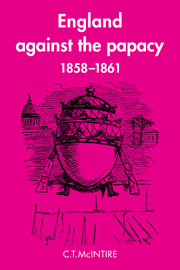 England Against the Papacy 1858–1861
England Against the Papacy 1858–1861 Book contents
- Frontmatter
- Contents
- Acknowledgments
- A note on the footnotes and abbreviations
- Maps
- Introduction
- 1 ‘English Liberties’ and ‘The Government of Priests’
- 2 Odo Russell and the network of English–papal relations
- 3 Tories, the pope, and peace
- 4 Tories, the pope, and war
- 5 Liberals and the revolution in the Romagna
- 6 Liberals, the congress and the Romagna
- 7 Liberals and the annexation of the Romagna
- 8 Liberals and the annexation of the Marches and Umbria
- Conclusion
- Select Bibliography
- Index
- Frontmatter
- Contents
- Acknowledgments
- A note on the footnotes and abbreviations
- Maps
- Introduction
- 1 ‘English Liberties’ and ‘The Government of Priests’
- 2 Odo Russell and the network of English–papal relations
- 3 Tories, the pope, and peace
- 4 Tories, the pope, and war
- 5 Liberals and the revolution in the Romagna
- 6 Liberals, the congress and the Romagna
- 7 Liberals and the annexation of the Romagna
- 8 Liberals and the annexation of the Marches and Umbria
- Conclusion
- Select Bibliography
- Index
Summary
‘The Papal Question is the Gordian knot of Italian politics, and its solution is indispensable to any permanent settlement of the Peninsula.’
Edinburgh Review (1860)‘One thing is quite certain, and that is, that no possible settlement of the vexed affairs of Italy can take place while the temporal dominions of the Pontiff stand in its midst, a moral plague spot, at once contagious and infectious.’
Illustrated London News (1860)For eleven hundred years before 1858 the popes of Rome were monarchs. Like other monarchs in the latter centuries of that epoch, they ruled over specific peoples and a definite territory. They promulgated laws, dispensed justice and collected taxes; they maintained an army, kept prisons and engaged in diplomacy. Unlike other monarchs, they governed as the Vicar of Christ on earth and head of the universal church. They called their state, the States of the Church, the Papal States. Their political rule was the papal temporal power. ‘God’ and Caesar were one.
Between 1858 and 1861, Pope Pius IX lost most of his people, his territory and his taxes. By means of war and revolution in Italy, and diplomatic power and intrigue in Europe, the papal monarchy was overthrown in most of the central Italian peninsula, first in the Romagna in June 1859, then in the Marches and Umbria in September 1860. The Kingdom of Piedmont-Sardinia annexed the Romagna in March 1860, and the Marches and Umbria in November 1860.
- Type
- Chapter
- Information
- England Against the Papacy 1858–1861Tories, Liberals and the Overthrow of Papal Temporal Power during the Italian Risorgimento, pp. 1 - 12Publisher: Cambridge University PressPrint publication year: 1983
